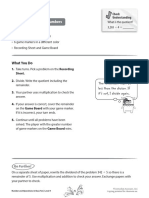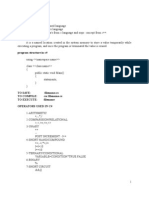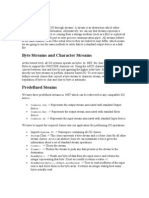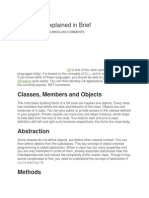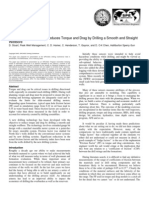C# Coding Conventions (C# Programming Guide)
Uploaded by
Sareeya ShreC# Coding Conventions (C# Programming Guide)
Uploaded by
Sareeya Shre12/9/2015
C#CodingConventions(C#ProgrammingGuide)
C# Coding Conventions C# Programming
Guide
Visual Studio 2015
The C# Language Specification does not define a coding standard. However, the guidelines in this topic are used by
Microsoft to develop samples and documentation.
Coding conventions serve the following purposes:
They create a consistent look to the code, so that readers can focus on content, not layout.
They enable readers to understand the code more quickly by making assumptions based on previous
experience.
They facilitate copying, changing, and maintaining the code.
They demonstrate C# best practices.
Naming Conventions
In short examples that do not include using directives, use namespace qualifications. If you know that a
namespace is imported by default in a project, you do not have to fully qualify the names from that
namespace. Qualified names can be broken after a dot . if they are too long for a single line, as shown in
the following example.
C#
varcurrentPerformanceCounterCategory=newSystem.Diagnostics.
PerformanceCounterCategory();
You do not have to change the names of objects that were created by using the Visual Studio designer
tools to make them fit other guidelines.
Layout Conventions
Good layout uses formatting to emphasize the structure of your code and to make the code easier to read.
Microsoft examples and samples conform to the following conventions:
Use the default Code Editor settings smart indenting, fourcharacter indents, tabs saved as spaces. For
more information, see Options, Text Editor, C#, Formatting.
Write only one statement per line.
https://msdn.microsoft.com/enus/library/ff926074.aspx
1/9
12/9/2015
C#CodingConventions(C#ProgrammingGuide)
Write only one declaration per line.
If continuation lines are not indented automatically, indent them one tab stop four spaces.
Add at least one blank line between method definitions and property definitions.
Use parentheses to make clauses in an expression apparent, as shown in the following code.
C#
if((val1>val2)&&(val1>val3))
{
//Takeappropriateaction.
}
Commenting Conventions
Place the comment on a separate line, not at the end of a line of code.
Begin comment text with an uppercase letter.
End comment text with a period.
Insert one space between the comment delimiter // and the comment text, as shown in the following
example.
C#
//Thefollowingdeclarationcreatesaquery.Itdoesnotrun
//thequery.
Do not create formatted blocks of asterisks around comments.
Language Guidelines
The following sections describe practices that the C# team follows to prepare code examples and samples.
String Data Type
Use the + operator to concatenate short strings, as shown in the following code.
C#
stringdisplayName=nameList[n].LastName+","+nameList[n].FirstName;
To append strings in loops, especially when you are working with large amounts of text, use a
https://msdn.microsoft.com/enus/library/ff926074.aspx
2/9
12/9/2015
C#CodingConventions(C#ProgrammingGuide)
StringBuilder object.
C#
varphrase="lalalalalalalalalalalalalalalalalalalalalalalalalalalalalala";
varmanyPhrases=newStringBuilder();
for(vari=0;i<10000;i++)
{
manyPhrases.Append(phrase);
}
//Console.WriteLine("tra"+manyPhrases);
Implicitly Typed Local Variables
Use implicit typing for local variables when the type of the variable is obvious from the right side of the
assignment, or when the precise type is not important.
C#
//Whenthetypeofavariableisclearfromthecontext,usevar
//inthedeclaration.
varvar1="Thisisclearlyastring.";
varvar2=27;
varvar3=Convert.ToInt32(Console.ReadLine());
Do not use var when the type is not apparent from the right side of the assignment.
C#
//Whenthetypeofavariableisnotclearfromthecontext,usean
//explicittype.
intvar4=ExampleClass.ResultSoFar();
Do not rely on the variable name to specify the type of the variable. It might not be correct.
C#
//NamingthefollowingvariableinputIntismisleading.
//Itisastring.
varinputInt=Console.ReadLine();
Console.WriteLine(inputInt);
Avoid the use of var in place of dynamic.
Use implicit typing to determine the type of the loop variable in for and foreach loops.
The following example uses implicit typing in a for statement.
C#
https://msdn.microsoft.com/enus/library/ff926074.aspx
3/9
12/9/2015
C#CodingConventions(C#ProgrammingGuide)
varsyllable="ha";
varlaugh="";
for(vari=0;i<10;i++)
{
laugh+=syllable;
Console.WriteLine(laugh);
}
The following example uses implicit typing in a foreach statement.
C#
foreach(varchinlaugh)
{
if(ch=='h')
Console.Write("H");
else
Console.Write(ch);
}
Console.WriteLine();
Unsigned Data Type
In general, use int rather than unsigned types. The use of int is common throughout C#, and it is easier
to interact with other libraries when you use int.
Arrays
Use the concise syntax when you initialize arrays on the declaration line.
C#
//Preferredsyntax.Notethatyoucannotusevarhereinsteadofstring[].
string[]vowels1={"a","e","i","o","u"};
//Ifyouuseexplicitinstantiation,youcanusevar.
varvowels2=newstring[]{"a","e","i","o","u"};
//Ifyouspecifyanarraysize,youmustinitializetheelementsoneatatime.
varvowels3=newstring[5];
vowels3[0]="a";
vowels3[1]="e";
//Andsoon.
https://msdn.microsoft.com/enus/library/ff926074.aspx
4/9
12/9/2015
C#CodingConventions(C#ProgrammingGuide)
Delegates
Use the concise syntax to create instances of a delegate type.
C#
//First,inclassProgram,definethedelegatetypeandamethodthat
//hasamatchingsignature.
//Definethetype.
publicdelegatevoidDel(stringmessage);
//Defineamethodthathasamatchingsignature.
publicstaticvoidDelMethod(stringstr)
{
Console.WriteLine("DelMethodargument:{0}",str);
}
C#
//IntheMainmethod,createaninstanceofDel.
//Preferred:CreateaninstanceofDelbyusingcondensedsyntax.
DelexampleDel2=DelMethod;
//Thefollowingdeclarationusesthefullsyntax.
DelexampleDel1=newDel(DelMethod);
trycatch and using Statements in Exception Handling
Use a trycatch statement for most exception handling.
C#
staticstringGetValueFromArray(string[]array,intindex)
{
try
{
returnarray[index];
}
catch(System.IndexOutOfRangeExceptionex)
{
Console.WriteLine("Indexisoutofrange:{0}",index);
throw;
}
}
Simplify your code by using the C# using statement. If you have a tryfinally statement in which the only
code in the finally block is a call to the Dispose method, use a using statement instead.
C#
https://msdn.microsoft.com/enus/library/ff926074.aspx
5/9
12/9/2015
C#CodingConventions(C#ProgrammingGuide)
C#
//ThistryfinallystatementonlycallsDisposeinthefinallyblock.
Fontfont1=newFont("Arial",10.0f);
try
{
bytecharset=font1.GdiCharSet;
}
finally
{
if(font1!=null)
{
((IDisposable)font1).Dispose();
}
}
//Youcandothesamethingwithausingstatement.
using(Fontfont2=newFont("Arial",10.0f))
{
bytecharset=font2.GdiCharSet;
}
&& and || Operators
To avoid exceptions and increase performance by skipping unnecessary comparisons, use && instead of
& and || instead of | when you perform comparisons, as shown in the following example.
C#
Console.Write("Enteradividend:");
vardividend=Convert.ToInt32(Console.ReadLine());
Console.Write("Enteradivisor:");
vardivisor=Convert.ToInt32(Console.ReadLine());
//Ifthedivisoris0,thesecondclauseinthefollowingcondition
//causesaruntimeerror.The&&operatorshortcircuitswhenthe
//firstexpressionisfalse.Thatis,itdoesnotevaluatethe
//secondexpression.The&operatorevaluatesboth,andcauses
//aruntimeerrorwhendivisoris0.
if((divisor!=0)&&(dividend/divisor>0))
{
Console.WriteLine("Quotient:{0}",dividend/divisor);
}
else
{
Console.WriteLine("Attempteddivisionby0endsuphere.");
}
New Operator
https://msdn.microsoft.com/enus/library/ff926074.aspx
6/9
12/9/2015
C#CodingConventions(C#ProgrammingGuide)
Use the concise form of object instantiation, with implicit typing, as shown in the following declaration.
C#
varinstance1=newExampleClass();
The previous line is equivalent to the following declaration.
C#
ExampleClassinstance2=newExampleClass();
Use object initializers to simplify object creation.
C#
//Objectinitializer.
varinstance3=newExampleClass{Name="Desktop",ID=37414,
Location="Redmond",Age=2.3};
//Defaultconstructorandassignmentstatements.
varinstance4=newExampleClass();
instance4.Name="Desktop";
instance4.ID=37414;
instance4.Location="Redmond";
instance4.Age=2.3;
Event Handling
If you are defining an event handler that you do not need to remove later, use a lambda expression.
C#
publicForm2()
{
//Youcanusealambdaexpressiontodefineaneventhandler.
this.Click+=(s,e)=>
{
MessageBox.Show(
((MouseEventArgs)e).Location.ToString());
};
}
C#
//Usingalambdaexpressionshortensthefollowingtraditionaldefinition.
publicForm1()
{
this.Click+=newEventHandler(Form1_Click);
https://msdn.microsoft.com/enus/library/ff926074.aspx
7/9
12/9/2015
C#CodingConventions(C#ProgrammingGuide)
}
voidForm1_Click(objectsender,EventArgse)
{
MessageBox.Show(((MouseEventArgs)e).Location.ToString());
}
Static Members
Call static members by using the class name: ClassName.StaticMember. This practice makes code more
readable by making static access clear. Do not qualify a static member defined in a base class with the
name of a derived class. While that code compiles, the code readability is misleading, and the code may
break in the future if you add a static member with the same name to the derived class.
LINQ Queries
Use meaningful names for query variables. The following example uses seattleCustomers for
customers who are located in Seattle.
C#
varseattleCustomers=fromcustincustomers
wherecust.City=="Seattle"
selectcust.Name;
Use aliases to make sure that property names of anonymous types are correctly capitalized, using Pascal
casing.
C#
varlocalDistributors=
fromcustomerincustomers
joindistributorindistributorsoncustomer.Cityequalsdistributor.City
selectnew{Customer=customer,Distributor=distributor};
Rename properties when the property names in the result would be ambiguous. For example, if your
query returns a customer name and a distributor ID, instead of leaving them as Name and ID in the result,
rename them to clarify that Name is the name of a customer, and ID is the ID of a distributor.
C#
varlocalDistributors2=
fromcustincustomers
joindistindistributorsoncust.Cityequalsdist.City
selectnew{CustomerName=cust.Name,DistributorID=dist.ID};
https://msdn.microsoft.com/enus/library/ff926074.aspx
8/9
12/9/2015
C#CodingConventions(C#ProgrammingGuide)
Use implicit typing in the declaration of query variables and range variables.
C#
varseattleCustomers=fromcustincustomers
wherecust.City=="Seattle"
selectcust.Name;
Align query clauses under the from clause, as shown in the previous examples.
Use where clauses before other query clauses to ensure that later query clauses operate on the reduced,
filtered set of data.
C#
varseattleCustomers2=fromcustincustomers
wherecust.City=="Seattle"
orderbycust.Name
selectcust;
Use multiple from clauses instead of a join clause to access inner collections. For example, a collection of
Student objects might each contain a collection of test scores. When the following query is executed, it
returns each score that is over 90, along with the last name of the student who received the score.
C#
//Useacompoundfromtoaccesstheinnersequencewithineachelement.
varscoreQuery=fromstudentinstudents
fromscoreinstudent.Scores
wherescore>90
selectnew{Last=student.LastName,score};
Security
Follow the guidelines in Secure Coding Guidelines.
See Also
Visual Basic Coding Conventions
Secure Coding Guidelines
2015 Microsoft
https://msdn.microsoft.com/enus/library/ff926074.aspx
9/9
You might also like
- C# & .NET Interview Questions 2024 Edition100% (1)C# & .NET Interview Questions 2024 Edition14 pages
- C Sharp Coding Guidelines and Best Practices 2No ratings yetC Sharp Coding Guidelines and Best Practices 249 pages
- Chapter 1 - Studying Development. Lifespan Development A Chronological Approach (Hoffnung Et. Al100% (1)Chapter 1 - Studying Development. Lifespan Development A Chronological Approach (Hoffnung Et. Al5 pages
- Deliver C# Software Faster With Source Code AnalysisNo ratings yetDeliver C# Software Faster With Source Code Analysis59 pages
- Chapter 8 - Object Oriented Programming in C#No ratings yetChapter 8 - Object Oriented Programming in C#16 pages
- Database. in COBOL or SQR Programs Reside Completely Within The File Server. If100% (2)Database. in COBOL or SQR Programs Reside Completely Within The File Server. If21 pages
- Automating Peoplesoft Environments in The Aws Cloud: April 2019100% (1)Automating Peoplesoft Environments in The Aws Cloud: April 201926 pages
- C Sharp: Presentation By:-Maheshwar Pandey XRG Consulting Pvt. Ltd. Mob - No - 7015337463No ratings yetC Sharp: Presentation By:-Maheshwar Pandey XRG Consulting Pvt. Ltd. Mob - No - 701533746312 pages
- Intdata An Array of Strings Twodarray A Two Dimensional ArrayNo ratings yetIntdata An Array of Strings Twodarray A Two Dimensional Array6 pages
- Introduction To Object Oriented Programming Concepts (OOPS) in C#.Net - ASP - Net, C#.NET, VBNo ratings yetIntroduction To Object Oriented Programming Concepts (OOPS) in C#.Net - ASP - Net, C#.NET, VB9 pages
- C# - Creating A Service To Monitor A DirectoryNo ratings yetC# - Creating A Service To Monitor A Directory6 pages
- Top 50 C# Interview Questions and AnswersNo ratings yetTop 50 C# Interview Questions and Answers10 pages
- Peopletools 8.4: Peoplecode Developer'S Guide100% (1)Peopletools 8.4: Peoplecode Developer'S Guide538 pages
- Mastering Java Persistence: From Basics to Expert ProficiencyFrom EverandMastering Java Persistence: From Basics to Expert ProficiencyNo ratings yet
- Visual Basic Project For BCA Final Year StudentNo ratings yetVisual Basic Project For BCA Final Year Student5 pages
- Differences Between Staphylococcus and Streptococcus - Microbiology NotesNo ratings yetDifferences Between Staphylococcus and Streptococcus - Microbiology Notes3 pages
- A Student's Guide To Considering Medication For Depression or AnxietyNo ratings yetA Student's Guide To Considering Medication For Depression or Anxiety7 pages
- C++ Program To Create A Student Database - My Computer ScienceNo ratings yetC++ Program To Create A Student Database - My Computer Science10 pages
- Chapter 2 - Theories of Development. Lifespan Development - A Chronological Approach (Hoffnung Et. Al0% (1)Chapter 2 - Theories of Development. Lifespan Development - A Chronological Approach (Hoffnung Et. Al17 pages
- List of International Prime Ministerial Trips Made by Imran Khan - WikipediaNo ratings yetList of International Prime Ministerial Trips Made by Imran Khan - Wikipedia15 pages
- Reducing Torque&Drag, New Drilling Tech (A, 12)No ratings yetReducing Torque&Drag, New Drilling Tech (A, 12)12 pages
- Grade 3 Social Studies Week 14 - 2022 - Consolidated WorksheetNo ratings yetGrade 3 Social Studies Week 14 - 2022 - Consolidated Worksheet9 pages
- Introduction To Financial and Managerial Accounting - ReadingsNo ratings yetIntroduction To Financial and Managerial Accounting - Readings5 pages
- Part Identification Bal COATS 1100, 1150-2DNo ratings yetPart Identification Bal COATS 1100, 1150-2D12 pages
- (Clarinet Institute) Dewagtere, Bernard - SarabandeNo ratings yet(Clarinet Institute) Dewagtere, Bernard - Sarabande8 pages




